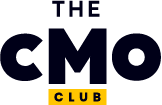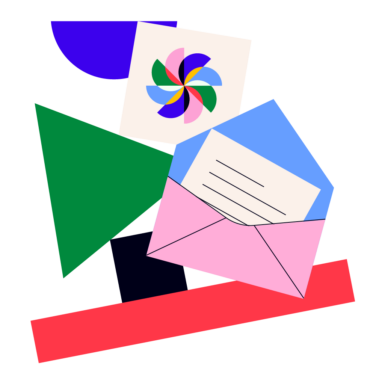Behind every high-growth SaaS company is a repeatable lead generation system—one built on strategy, not scattered tactics. The best teams align their channels, content, and messaging to match how buyers actually evaluate and purchase software. In this guide, I break down 15 B2B SaaS lead generation strategies designed to attract, engage, and convert high-fit prospects across the entire buyer journey. These aren’t quick hacks or isolated channels but strategic motions you can operationalize and scale.
Whether you’re launching your first motion or optimizing an existing engine, this guide will help you develop lead gen strategies to:
- Capture demand from buyers already in-market
- Build trust and visibility in the mid-funnel
- Create awareness that compounds over time
- Drive pipeline with clarity, consistency, and control
Lead Generation Strategy Map
Each strategy below maps to a specific part of the funnel so you can build a lead gen system that’s not just comprehensive, but cohesive.
Demand Capture (Bottom of Funnel)
Generate pipeline from in-market buyers actively searching for solutions:
- Capture In-Market Demand with Paid Advertising (PPC & PPL)
- Activate Targeted Outbound with Cold Email
- Accelerate Sales Cycles with Personalized Live Demos
- Convert Website Traffic in Real-Time with Chatbots & Conversational Tools
Demand Creation (Top to Mid Funnel)
Build awareness, thought leadership, and future pipeline:
- Create Compound Visibility with Scalable Content (SEO + AI)
- Build Thought Leadership Through Webinar & Event Sponsorship
- Expand Reach and Credibility Through Co-Marketing Partnerships
- Use Video to Educate, Build Trust, and Humanize Your Brand
- Earn Authority and Trust Inside Niche Communities
Conversion & Nurture
Turn attention into action, and leads into revenue:
- Convert Visitors with Value-Based Lead Magnets
- Accelerate Consideration with Case Studies & Testimonials
- Maximize Conversion with Intent-Aligned Landing Pages
- Let Prospects Self-Qualify with Free Trials or Freemium Access
Customer-Led Growth
Let your happiest customers drive your next best leads:
- Turn Happy Customers Into a Scalable Referral Channel
- Nurture Pipeline Through Relationship-Driven Social Selling
Each strategy includes examples, tools, and tips to help you put it into action so you can build a lead gen engine that compounds over time.
Before we dive into specific strategies, it’s worth aligning on what lead generation actually means in a SaaS context, and why it’s uniquely challenging.
What is B2B SaaS Lead Generation?
B2B SaaS lead generation is the structured process of attracting and converting the right prospects into future customers. It goes beyond capturing emails. B2B SaaS lead generation is about designing a system that identifies high-fit buyers, earns their trust, and moves them through the funnel with intent.
The Core Stages of the Lead Gen Process:
- Attract: Drive awareness through content, advertising, and organic channels
- Capture: Turn interest into contacts through forms, trials, and gated content
- Qualify: Score and segment leads based on firmographic and behavioral fit as well buying intent
- Nurture: Educate and engage prospects, guiding them through a nurture sequence of educational content and personalized outreach
- Convert: Transform qualified leads into paying customers through sales engagement
Lead generation means different things at different stages of growth. For a pre-seed startup, it’s about finding beta users to validate the MVP. For companies moving from product–market fit to initial revenue, it’s about proving traction and laying the groundwork for a go-to-market (GTM) team. And for Series A/B+ companies with stable revenue, lead generation becomes the fuel powering the rocket toward scale, and ultimately, a successful exit.
Why SaaS Lead Gen is Different
SaaS lead gen is uniquely challenging compared to traditional B2B models including longer sales cycles, complex buyer committees involving multiple stakeholders, and subscription-based revenue models that require demonstrating ongoing value rather than one-time purchases. This requires:
- A mix of demand creation and demand capture tactics
- Clear alignment between marketing, product, and sales
- Strategic content that performs across both search and AI surfaces
Let’s clarify how SaaS marketers are redefining what counts as a lead.
Types of SaaS Leads
Gone are the days when MQLs and SQLs ruled the funnel. Today’s marketing leaders are shifting their focus to account-based and product-qualified leads aligning lead definitions with real buying behavior. This reflects a deeper understanding of jobs-to-be-done (JTBD) and acknowledges that it’s the buying committee, not just individual stakeholders, driving decisions in the SaaS world.
| Lead Type | Definition | Funnel Stage | Qualification Level | Typical Source |
| Cold Leads | Prospects with no prior interaction | Top of Funnel | Unqualified | Purchased lists, cold outreach |
| Marketing Qualified Leads (MQLs) | Prospects who've engaged with marketing content | Middle of Funnel | Basic qualification | Content downloads, webinars |
| Sales Qualified Leads (SQLs) | Prospects vetted and approved by sales | Middle-Bottom Funnel | High qualification | Sales development outreach |
| Product Qualified Leads (PQLs) | Users who've experienced value in your product | Bottom of Funnel | Very high qualification | Free trials, freemium usage |
| Sales Qualified Accounts (SQAs) | Entire accounts showing buying intent across multiple touchpoints | Bottom of Funnel | Account-level qualification | Multi-threaded engagement, intent signals |
| Customer Referrals | Prospects recommended by existing customers | Variable | Pre-qualified | Referral programs, word-of-mouth |
If marketing teams are still measuring MQLs in 2025 to prove “effectiveness”, then they are creating regressive playbooks. This is the age of PQLs (Product Qualified Leads) & SQAs (Sales Qualified Accounts). If you’re selling enterprise-grade software, you can’t be single-threading—you need ways to measure reach, engagement, buying intent, and competitive intelligence at an account level.
B2B SaaS Lead Gen Strategy Map by Funnel Stage
There’s no single play that drives SaaS growth—just systems that compound over time. The 15 strategies below are organized by their role in the funnel, so you can see how they work together. Use this as your blueprint for building a balanced, scalable lead gen engine.
Demand Capture: Convert In-Market Intent into Pipeline
When prospects are already researching solutions, your job is to intercept that intent with relevance, speed, and clarity. Demand capture strategies are designed to convert existing buyer interest—whether it’s happening on Google, LinkedIn, inboxes, or your website—into qualified pipeline. These plays aren’t about building awareness; they’re about helping buyers take action now.
Done right, demand capture fuels short-term growth, supports sales velocity, and creates a measurable path from intent signal to closed-won.
Here are four core strategies to help you do just that:
- Use paid media to reach high-intent buyers when and where they’re actively researching
- Launch cold outbound that’s personalized, relevant, and account-aware
- Accelerate buying decisions with live, high-impact demos
- Capture and qualify inbound visitors instantly with always-on chat
1. Capture In-Market Demand with Paid Media (PPC & PPL)
Paid media powers rapid pipeline growth in B2B SaaS—when you manage cost, complexity and lead quality. The most effective B2B SaaS teams typically run two core paid strategies:
- Pay-Per-Click (PPC) to capture active intent
- Pay-Per-Lead (PPL) to guarantee qualified contacts
Balance both to scale predictably without overpaying for unqualified clicks.
Pay-Per-Click campaigns for B2B SaaS Lead Gen
Pay-Per-Click campaigns put your message in front of buyers the moment they search—whether on Google, LinkedIn, Facebook or niche review sites like G2 and Capterra. Specialist B2B SaaS lead-gen platforms such as Revleads then layer on industry-specific audience filters, hands-on vetting and conversion tuning to squeeze more ROI out of every click. Ideal for teams who need scalable, in-market demand without the one-size-fits-all guesswork of generic ad networks.
Why it works: Reaches buyers at peak intent—whether they’re typing a query or scrolling their feed—while pre-built filters keep irrelevant clicks out.
When to use it:
- Rapidly test new keywords, verticals or geographies
- Amplify proven organic search performance
- Drive urgency around product launches or promotions
How to measure success:
- CTR: 3–5% on search & social ads
- Quality Score: ≥ 7 for efficient spend
- CPL: 20–30% below customer LTV
- ROAS: ≥ 3:1
Pro tips:
- Lean into long-tail, buyer-led keywords (e.g. “enterprise HR analytics software”)
- Use sitelinks, callouts & structured snippets to boost real estate
- Align ad copy, landing pages & CTAs for perfect continuity
- Rotate creatives weekly to prevent audience fatigue
Pay-Per-Click for B2B SaaS Lead Gen: Platform Comparison
| Platform | Pros | Cons |
| Revleads Pay Per Click | • Drives double-digit conversion rates for high-intent clicks • Real-time bidding & optimization in one self-serve dashboard • Advanced ICP filters and manual vetting ensure top-tier quality | • Minimum spend thresholds • Less DIY control than pure self-serve |
| Google Ads | • Unmatched search volume & intent data • Full suite of ad formats • Automated bidding | • Rising CPCs in competitive niches • Broad match can waste spend |
| Microsoft Advertising | • 20–30% lower CPCs vs. Google • Reaches Bing/Yahoo/AOL audience | • Smaller volume than Google • Fewer advanced features |
| LinkedIn Ads | • Precision by company, role, seniority • Excellent for enterprise | • Very high CPCs • Lower CTR than search |
| Facebook & Instagram Ads | • Powerful look-alike & interest targeting • Lower CPCs for SMB | • Weak B2B intent signals • Ads can feel “off-brand” |
| G2 Sponsored | • Buyers deep in evaluation • Contextual, review-driven | • Expensive per click/lead • Requires tight profile setup |
| Capterra Ads | • Captures active software searchers • Highly relevant context | • Costly per lead • Limited audience scale |
| Quora Ads | • Reaches users asking B2B product questions • Thought-leadership positioning | • Niche volume • Can require careful targeting setup |
| Reddit Ads | • Access to focused communities (e.g. r/SaaS) • Highly engaged audiences | • Mixed B2B intent • Moderation and ad acceptance varies |
| Stack Overflow Ads | • Direct reach to developers & technical buyers • High intent on problem pages | • Limited to tech audiences • Higher CPCs for niche tags |
| Programmatic Native | • Broad reach via Outbrain/Taboola • Drives “intent-adjacent” traffic | • Lower direct intent • Harder to track ROI |
| Twitter Ads | • Good for event-driven promos & thought leadership • Conversation targeting | • Lower B2B intent • Short content lifespan |
| Amazon Ads | • Useful if you sell integrations or ebooks • Leverages Amazon’s intent signals | • Not core for pure-play SaaS • Limited targeting options |
Pay-Per-Lead campaigns for B2B SaaS Lead Gen
Pay-Per-Lead campaigns charge only for prospects who’ve already shown intent—ideal for teams focused on outcomes, not impressions. While well-known platforms like G2 or Capterra offer lead programs, specialist B2B SaaS providers such as Revleads go further: they source and qualify buyers against your ICP via phone or chat, enrich each lead with budget and timeline details, and tune performance in real time. This approach delivers a predictable volume of high-intent contacts, slashes wasted spend on unqualified traffic, and frees your reps to focus on closing—not screening. Ideal for teams that need consistent, budget-friendly pipeline without the guesswork of click-based models.
Why it works: Guarantees lead quality by billing exclusively for contacts who meet your ICP criteria, eliminating wasted spend on unqualified clicks.
When to use it:
- When CPCs on search or social spike beyond budget
- To tap tightly defined vertical or niche segments
- For predictable, volume-driven pipeline delivery
How to measure success:
- CPL: 20–30% below customer LTV
- Lead Quality: % meeting BANT/GAP standards
- Pipeline Velocity: Time from lead delivery to opportunity
- Close Rate: Benchmarked vs. in-house sourced leads
Pro tip: Define ICP traits (industry, company size, tech stack) before launch
Pay-Per-Lead for B2B SaaS Lead Gen: Platform Comparison
| Platform | Pros | Cons |
| Revleads Pay Per Lead | • Phone- and chat-qualified leads that match your exact ICP • Predictable, budget-friendly volume with no wasted spend • Instant visibility into lead details (budget, timeline, scope) | • Minimum spend thresholds • Less DIY than pure marketplace |
| G2 Sponsored Leads | • Buyers deep in evaluation • Contextual placement on review pages | • High CPL in competitive categories • Requires tight profile upkeep |
| Capterra Leads | • Captures active software searchers • Established vendor comparison hub | • Costly per lead • Limited to Capterra’s audience scale |
| TrustRadius PPL | • In-depth review context builds trust • High review-reader engagement | • Smaller volume than G2/Capterra • Premium pricing tiers |
| SoftwareAdvice | • SMB and mid-market focus • Qualified appointment scheduling option | • Niche audience skew • Lead volume can vary by category |
2. Activate Outbound with Targeted Cold Email
Cold email remains one of the most effective B2B lead generation channels when executed strategically. With 59% of companies considering email the most reliable channel for lead generation, and email delivering the highest ROI of $36-42 for every dollar spent, it can produce the lowest customer acquisition cost among all channels. Typically, cold emailing involves these key steps:
- Research and Segmentation: Identify ideal customer profiles (ICP) and build targeted prospect lists. Having a clear understanding of your ICP will help you target the accounts that are most likely to convert later down the line.
- Building a list: Build a high quality list of prospects pulling data from your CRM, enrichment tools, or manual LinkedIn research. Prioritize by intent signals, tech stack, or recent hiring activity. Validate emails and job titles before outreach begins.
- Craft compelling subject lines: Keep them short, specific, and curiosity-driven.
- Personalize your message: Reference specific pain points, recent company news, or mutual connections.
- Include clear Call-to-Action: Focus on one specific, low-commitment next step.
- Follow-up strategically: Send 3-5 follow-up emails spaced 3-7 days apart.
Why it works: Direct, personalized communication allows you to reach decision-makers who may not discover your solution through other channels, while building genuine relationships and brand awareness.
When to use it: Best for targeting specific accounts, reaching C-level executives, and when you have clear value propositions for defined segments. Focus on relationship-building rather than immediate sales.
How to measure success:
- Open rates (industry average: 20-25%)
- Reply rates (target: 5-10%)
- Meeting booking rates (target: 1-3%)
- SQL conversion rates
Pro tips:
- Send emails Tuesday-Thursday between 10-11 AM for highest open rates
- Keep emails under 150 words
- Use social proof and specific results rather than generic benefits
- A/B test subject lines and email copy continuously
- Focus on hyper-personalization based on signals, intent, and genuine purpose rather than generic templated outreach
Cold emails, by nature, are sent to prospects who have no prior relationship or experience with your SaaS brand. Use a cold template like the one below to introduce yourself and provide proof points to encourage your prospect to engage with you.
Cold Email Template
Subject: Quick question about [Company]’s [specific challenge]
Hi [First Name],
I noticed [Company] recently [specific trigger event/news]. Given your role as [Title], I imagine you’re focused on [relevant business objective].
I’m reaching out because we help [similar companies/titles] [achieve specific outcome] without [common pain point].
For example, [Similar Company] saw [specific result] in [timeframe] using our approach.
Would you be open to a brief 15-minute call next week to discuss how this might apply to [Company]’s situation?
Kind regards,
[Your name]
3. Accelerate Sales Cycles with Personalized Live Demos
Live product demonstrations and consultations provide personalized experiences that address specific prospect needs while showcasing your solution's capabilities. This cross-functional strategy involves marketing, sales, and product teams working together.

Why it works: Allows for real-time objection handling and customized presentations that address specific use cases and concerns.
When to use it: Most effective for complex solutions with longer sales cycles and multiple stakeholders in the buying process.
How to measure success:
- Demo request conversion rates
- Demo-to-opportunity conversion rates
- Average deal size from demo-sourced leads
- Sales cycle length for demo attendees
Companies like Gong optimize their demo process with dedicated landing pages and instant scheduling options, making it easy for prospects to book demonstrations at their convenience.
Pro tips:
- Qualify prospects before demos to ensure good fit and preparation
- Customize demos to show relevant use cases and industry examples
- Include multiple stakeholders when possible
- Follow up within 24 hours with recap and next steps
4. Convert Website Traffic in Real-Time with Chatbots & Conversational Tools
Chatbots provide immediate response to website visitors while qualifying leads and routing them to appropriate sales resources. Modern AI-powered chatbots can handle complex conversations and provide personalized experiences.
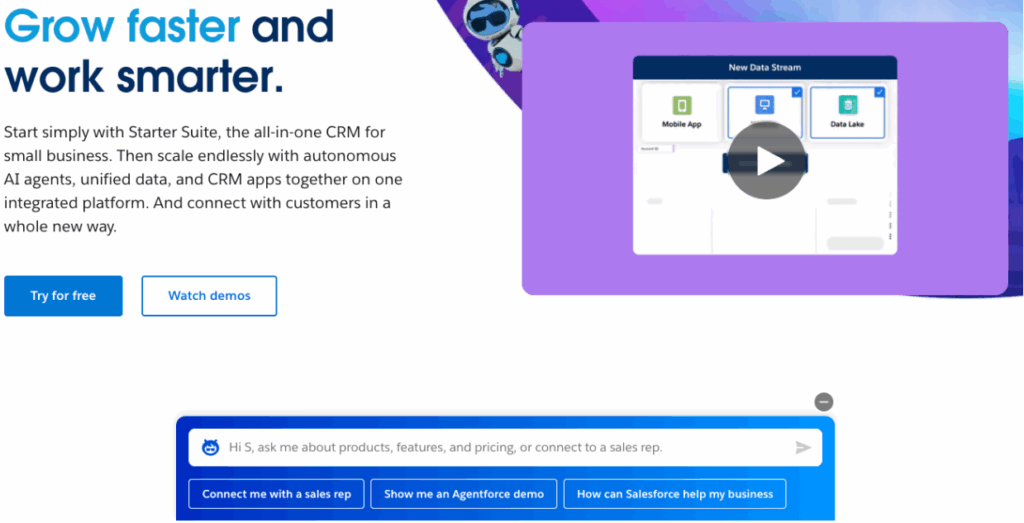
Why it works: Captures leads who might otherwise leave without engaging while providing instant gratification for prospects seeking immediate answers.
When to use it: Effective for websites with high traffic volume and companies that want to provide 24/7 lead capture and qualification.
Here’s how Chatbots can help with B2B SaaS lead generation:
- Instant lead qualification: Ask screening questions to determine prospect fit and buying stage
- Meeting scheduling: Allow qualified prospects to book sales calls directly through the chat interface
- Content recommendations: Suggest relevant resources based on prospect interests and challenges
- Retargeting integration: Capture contact information for prospects who don't convert immediately
- Lead routing: Direct qualified leads to appropriate sales team members based on territory or expertise
How to measure success:
- Chat engagement rates
- Lead conversion rates from chat interactions
- Meeting booking rates through chat
- Customer satisfaction scores for chat experiences
Pro tips:
- Design conversation flows that feel natural and helpful
- Provide easy escalation to human agents when needed
- Use chatbots to gather information before human handoffs
- Integrate chat data with your CRM for complete lead tracking
Demand Creation: Build Awareness, Trust, and Future Pipeline
Not all buyers are ready to purchase today, but that doesn’t mean you can’t influence them. Demand creation strategies focus on earning attention, building credibility, and planting seeds for future pipeline. These plays are designed to educate, inspire, and position your solution before a prospect even enters an active buying cycle.
Done right, demand creation builds brand equity, shortens sales cycles, and ensures you're in the consideration set when intent finally appears.
Here are five core strategies to help you do just that:
- Create compound visibility with scalable content that performs across SEO and AI surfaces
- Build trust and thought leadership through sponsored webinars and roundtables
- Multiply reach by partnering with complementary brands via co-marketing
- Use video to simplify complex ideas and connect with buyers emotionally
- Earn trust and credibility inside the communities your buyers already rely on
5. Create Compound Visibility with Scalable Content (SEO + AI)
Content marketing remains one of the most efficient and scalable levers for long-term growth in B2B SaaS. It builds brand authority, fuels steady organic traffic, and compounds over time. HubSpot’s blog is a standout example: high-value content consistently attracts millions of visits and thousands of leads.
But the content landscape is shifting. As AI-generated search results and chatbot-driven discovery reshape how buyers research, traditional SEO is no longer enough. Smart marketers are investing in AEO (Answer Engine Optimization) and GEO (Generative Engine Optimization) to ensure their content is surfaced not just in search rankings, but also in AI-powered summaries and conversations.
To stay visible and relevant, brands need broad, consistent content coverage across keywords, topics, and channels—not just to rank, but to be seen, cited, and trusted in every buyer journey.
Content Creation & Distribution Services for B2B SaaS Lead Gen
That’s where content creation and distribution services come into their own. Rather than managing freelancers, SEO tools, and distribution piecemeal, platforms like Revleads offer a full-stack solution: strategy, expert writing, performance tracking, and—critically—distribution into a curated network of high-quality B2B SaaS publications and communities.
This means your content is placed directly in front of high-intent, in-market buyers who are already researching solutions like yours. In an AI-first discovery environment, where visibility and brand authority drive conversion long before a demo request, that level of placement matters.
The result: sustained organic traffic, stronger brand presence, and a pipeline that builds for the long term without the operational overhead of managing content in-house. Ideal for SaaS teams looking to scale both awareness and acquisition efficiently.
Why it works: Leverages expert content creation and established distribution channels while providing comprehensive performance tracking and lead attribution without operational overhead.
When to use it:
- Scale content production without hiring full-time writers
- Access industry expertise and established distribution networks
- Drive consistent organic traffic and lead generation with predictable costs
- Building awareness and pipeline in parallel
How to measure success:
- Organic traffic growth: 15-25% month-over-month
- Content-driven lead conversions: 2-5% of organic visitors
- Time on page: 3+ minutes for long-form content
- Keyword ranking improvements: Top 10 positions for target terms
Pro tips:
- Optimize content for both SEO and AI-generated summaries
- Track content-attributed leads through to pipeline and revenue
- Repurpose high-performing content across email, paid, and social
Content Services for B2B SaaS Lead Gen: Platform Comparison
| Platform | Pros | Cons |
| Revleads | • Strategic, high-quality content tailored for B2B SaaS • Distributed across trusted publications & communities • Access to in-market, high-intent buyers | • Higher cost per piece than DIY solutions • Requires upfront strategy alignment |
| Scripted | • Large freelance writer network • Easy content ordering platform | • Limited strategic oversight • No distribution • Variable content quality |
| ContentKing | • Strong SEO tools and optimization capabilities | • No integrated distribution • Primarily focused on SEO hygiene, not content that converts |
| Rock Content | • Offers content analytics and multi-language support | • Limited SaaS expertise • Complex pricing • No native audience reach |
| ClearVoice | • Workflow tools and editorial calendar • Access to subject matter experts | • Content-first, distribution-absent model • High cost for limited ROI if unmanaged |
| Industry Publications | • Built-in audience trust and niche authority • Great for co-branded thought leadership | • Limited scale and format flexibility • Longer lead times and less strategic control |
6. Build Thought Leadership Through Webinar & Event Sponsorship
Webinars provide educational value while generating high-quality leads through registration and attendance. With 73% of B2B marketers considering webinars the best way to generate high-quality leads, they offer unique opportunities for extended prospect engagement.
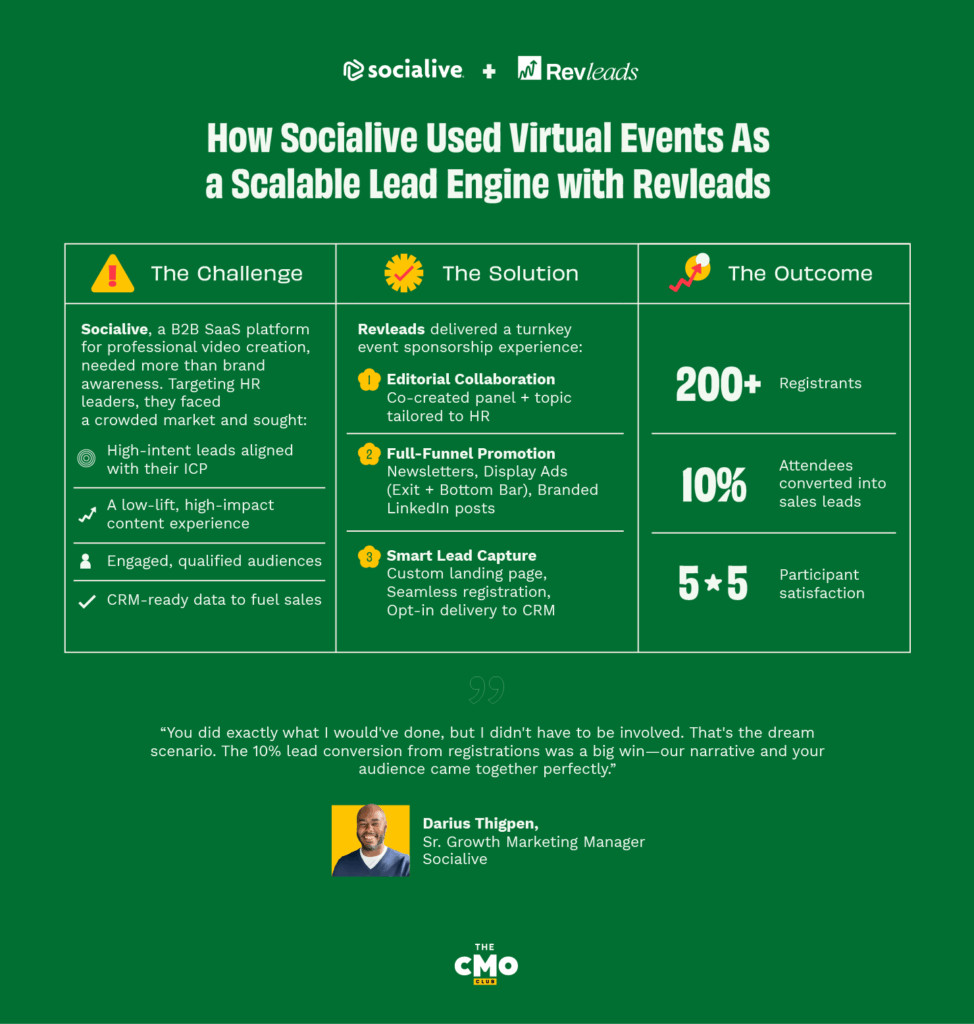
Webinars & Virtual Event Sponsorship for B2B SaaS Lead Gen
Event sponsorship is a strategic way to reach engaged, high-fit audiences by aligning your brand with trusted content and sparing yourself the cost and complexity of hosting events. Webinars are a common format, but sponsorships can also include roundtables, virtual conferences, AMAs, and more. While these activations tend to sit higher in the funnel than PPC or PPL, they’re powerful tools for moving prospects from awareness to consideration, especially when paired with thoughtful content and strong distribution.
Specialist B2B SaaS lead generation platforms like Revleads handle everything from editorial collaboration and speaker curation to promotion and smart lead capture—giving you access to new audiences, warm leads, and brand-building opportunities without the operational lift. Ideal for teams looking to drive both thought leadership and pipeline with minimal overhead.
Why it works: Leverages established audiences and expert content creation while providing comprehensive promotion and qualified lead delivery without operational overhead.
When to use it:
- Rapidly enter new markets or verticals with established audiences
- Access high-quality content and speakers without internal resources
- Drive consistent pipeline without webinar production investment
How to measure success:
- Registration rates: 15-25% of promoted audience
- Attendance rates: 40-60% of registrants
- Lead quality: % meeting BANT/ICP criteria
- Pipeline velocity: Time from lead delivery to opportunity
Pro tips:
- Request attendee engagement data for follow-up prioritization
- Combine with display advertising for maximum reach
Webinar Sponsorship for B2B SaaS Lead Generation: Platform Comparison
| Platform | Pros | Cons |
| Revleads | • Turnkey event sponsorships with editorial collaboration • Promotion across trusted SaaS channels (newsletters, display, LinkedIn) • High-intent lead capture with CRM-ready data | • Minimum spend required • Less control over scheduling and format |
| BrightTALK | • Large B2B tech audience • Professional production and platform analytics | • High competition for attention • Limited event customization |
| Maven Collective | • Focused on B2B SaaS and tech • Custom messaging for niche personas | • Smaller audience scale • Limited execution across regions |
| GPJ | • Full-service global event execution • Strong creative and branding capabilities | • High cost • Long lead times for enterprise-level campaigns |
| Opus Agency | • Integrated marketing + event strategy • Data-driven post-event performance tracking | • Cost-prohibitive for lean teams • Less agile for one-off activations |
| Industry Publications | • Built-in audience trust • Strong editorial alignment with niche verticals | • Limited reach beyond their own subscriber base • Rigid formats and lead times |
7. Expand Reach and Credibility Through Co-Marketing Partnerships
Co-marketing involves partnering with complementary businesses to create joint marketing campaigns that reach both audiences. This strategy expands your reach while sharing costs and leveraging partner credibility.
Why it works: Provides access to new audiences through trusted partner relationships while reducing individual marketing costs.
Co-marketing Example:
HubSpot, the inbound marketing powerhouse, joined forces with Unbounce, the leading landing-page builder, to co-create The Conversion Marketer’s Guide to Landing Page Copywriting. This joint eBook addressed a shared ICP: marketers and CRO specialists looking to improve website conversions. The result was over 3,000 new leads for both companies, significantly expanding reach at a fraction of the individual cost.
How to measure success:
- Leads generated through partner channels
- Cross-partner audience engagement rates
- Joint campaign conversion rates
- Partner-influenced pipeline value
8. Use Video to Educate, Build Trust, and Humanize Your Brand
Video content engages audiences more effectively than text-based content while building trust through visual demonstration and personal connection. B2B buyers increasingly prefer video content for learning about complex solutions.
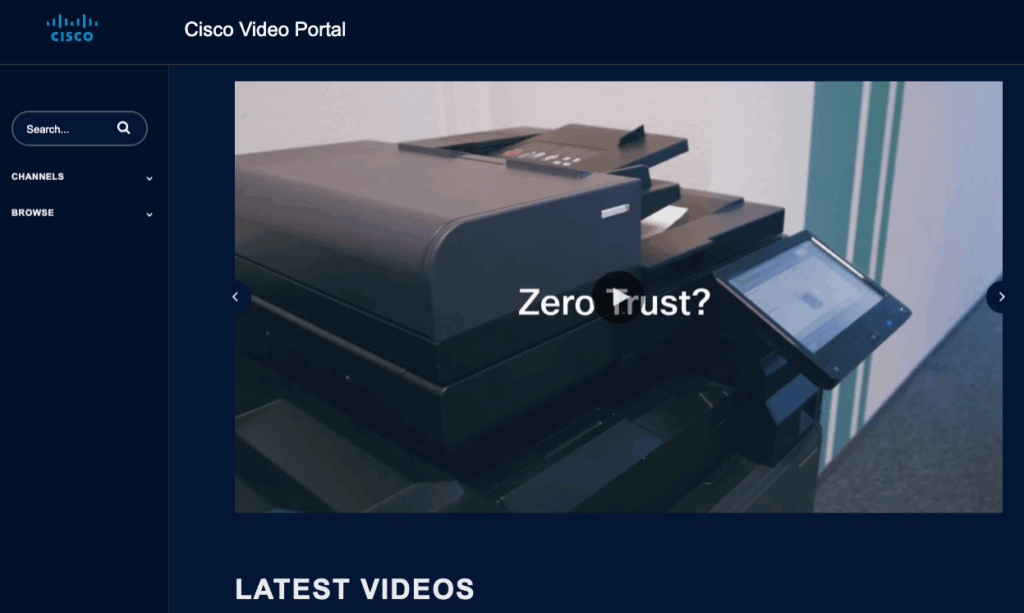
Why it works: Explains complex concepts clearly while building personal connections with prospects through visual and audio engagement.
When to use it: Particularly effective for product demonstrations, thought leadership, customer testimonials, and educational content.
How to measure success:
- Video view rates and completion rates
- Lead generation from video CTAs
- Engagement metrics (likes, shares, comments)
- Pipeline influence from video content
Pro tips:
- Optimize video titles and descriptions for search
- Create playlists for different buyer personas and journey stages
- Include clear CTAs within videos and descriptions
- Repurpose long-form content into shorter social media clips
9. Earn Authority and Trust Inside Niche Communities
Building and participating in relevant communities allows you to establish thought leadership while generating leads through authentic relationship building. This includes industry forums, Reddit communities, and professional groups.
A strong community engagement strategy starts by identifying where your target audience naturally gathers online—whether that’s Reddit, LinkedIn groups, Slack communities, or niche forums.
Once there, focus on contributing valuable insights and answering questions without jumping into self-promotion. Share relevant content that genuinely helps community members, positioning yourself as a helpful resource rather than a seller.
Prioritize building authentic relationships and trust before introducing any sales conversation. Throughout, keep a close eye on brand mentions and broader industry discussions to stay informed and engage in real time when relevant.
Happy customers also have friends! Building genuine communities around your customers creates natural referral networks and expansion opportunities.
Why it works: Builds trust and credibility through helpful contributions rather than direct selling, leading to higher-quality lead relationships and organic referral generation.
When to use it: Most effective for complex solutions where buyers need education and social proof before making decisions.
How to measure success:
- Community engagement metrics
- Inbound inquiries from community participation
- Brand mention sentiment and volume
- Relationship quality and trust indicators
Pro tips:
- Follow community rules strictly and focus on value-first engagement
- Use personal profiles rather than company accounts for authentic interactions
- Share experiences and insights rather than promotional content
- Build genuine relationships that extend beyond lead generation
Conversion & Nurture: Turn Attention into Action, and Leads into Revenue
Getting attention is one thing—turning it into pipeline is another. Conversion and nurture strategies are built to bridge that gap. They help you capture interest, reinforce buyer confidence, and move prospects from curiosity to commitment.
These plays work best once you've attracted the right audience and need to guide them toward a decision—whether it's through compelling proof, frictionless experiences, or product-led validation.
Done right, these strategies increase lead-to-opportunity conversion rates, reduce drop-off, and drive more efficient pipeline from the traffic you’re already generating.
Focus on these four core strategies:
- Convert website visitors with value-based lead magnets
- Accelerate mid-funnel decisions using case studies and testimonials
- Improve conversion rates with landing pages built for intent
- Let prospects self-qualify with free trials that show real product value
10. Convert Visitors with Value-Based Lead Magnets
Lead magnets are valuable resources offered in exchange for contact information, serving as the gateway to your marketing funnel. Effective lead magnets address specific problems your ideal customers face while demonstrating your expertise.

Why it works: Provides immediate value to prospects while capturing contact information for nurturing campaigns.
When to use it: Essential for content marketing strategies, paid advertising campaigns, and website optimization efforts.
Types of High-Converting Lead Magnets:
- Industry reports and research studies
- Templates and checklists
- Free tools and calculators
- Exclusive webinars or video series
- Free trials
How to measure success:
- Conversion rates on landing pages
- Lead quality scores
- Pipeline progression from lead magnet downloads
Pro tips:
- Make lead magnets highly specific to particular use cases
- Ensure the resource can be consumed quickly (under 30 minutes)
- Gate only your highest-value content
- Use compelling headlines that emphasize the outcome, not the format
11. Accelerate Consideration with Case Studies and Testimonials
Case studies and customer testimonials provide social proof that reduces buying risk and accelerates decision-making. McKinsey's case studies demonstrate how detailed success stories can attract similar prospects.
Why it works: Buyers trust peer experiences more than vendor claims, making case studies powerful tools for overcoming objections and building confidence.
When to use it: Most effective during the consideration and decision phases of the buying journey, and for targeting similar companies to your success stories.
Here’s the process to follow if you want to generate leads from your case studies and testimonials:
- Identify your best success stories: Choose customers who achieved measurable results and represent your ideal customer profile
- Gather quantitative results: Document specific metrics, ROI, and business outcomes achieved
- Create multiple formats: Develop written case studies, video testimonials, and one-page summaries for different use cases
- Distribute strategically: Feature case studies on your website, in sales presentations, and as content for nurturing campaigns
- Promote actively: Share case studies on social media, include in email campaigns, and use in paid advertising
How to measure success:
- Conversion rates from case study CTAs
- Sales team usage and feedback
- Pipeline influence and deal velocity
Pro tips:
- Include specific numbers and percentages whenever possible
- Address common objections within case studies
- Create industry-specific case studies for different market segments
- Use customer quotes that sound authentic and conversational
12. Maximize Conversion with Intent-Aligned Landing Pages
Optimized landing pages are crucial for converting traffic from all your lead generation channels. Even small improvements in conversion rates can significantly impact overall lead volume and quality.
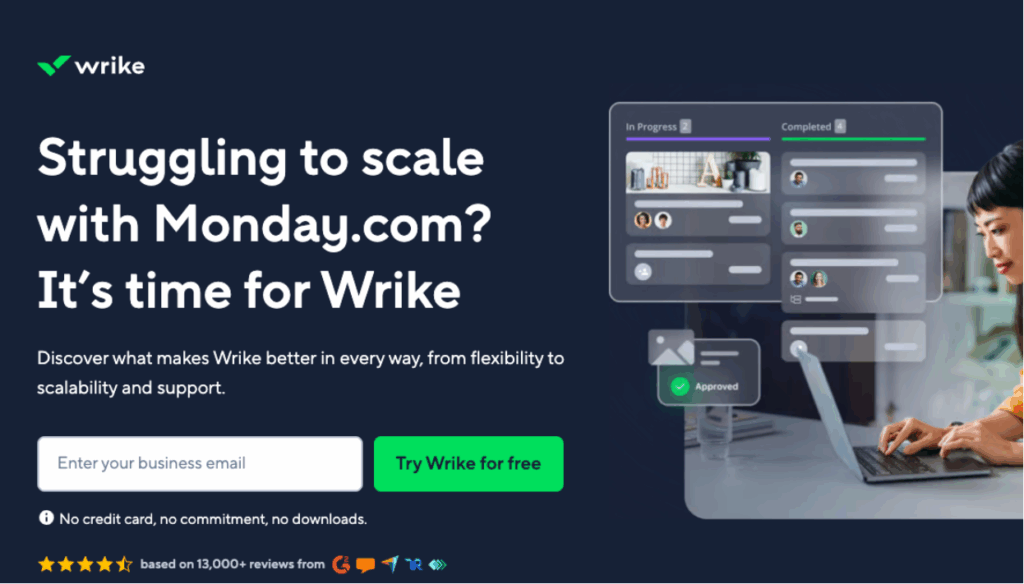
Why it works: Removes friction and guides visitors toward conversion through focused messaging and clear calls-to-action.
Follow these 5 steps to optimize your landing page:
- Align messaging with traffic source: Ensure headlines and copy match the ad or link that brought visitors to the page
- Simplify forms: Request only essential information and use progressive profiling for additional data
- Create compelling headlines: Focus on outcomes and benefits rather than features
- Add social proof: Include testimonials, customer logos, and trust badges to build credibility
- Test continuously: A/B test headlines, CTAs, form fields, and page layouts to improve performance
Companies like Wrike excel at creating focused landing pages that convert visitors through clear value propositions and streamlined user experiences.
How to measure success:
- Landing page conversion rates
- Bounce rates and time on page
- Form completion rates
- Lead quality scores from different pages
13. Let Prospects Self-Qualify with Free Trials or Freemium Access
Product-led growth through free trials and freemium models allows prospects to experience value before making purchase decisions. With 66% of B2B conversions coming from free trials, this strategy is particularly powerful for SaaS companies.
Modern buyers expect to engage, experience & experiment in ‘Playground Mode’ and self-qualify rather than waiting for custom demos or pre-screening calls.
This shift toward self-service evaluation makes free trials essential for competitive differentiation.
Why it works: Removes friction from the buying process and allows prospects to validate your solution's value in their own environment while supporting the modern buyer's preference for self-service evaluation.
When to use it: Most effective for products with clear value propositions that can be demonstrated quickly and don't require extensive implementation.
To build a successful free trail program, here are the steps you can take:
- Determine optimal trial length: Balance enough time to show value (typically 14-30 days) without creating decision paralysis
- Remove friction from signup: Minimize required information and eliminate credit card requirements when possible
- Provide guided onboarding: Create structured experiences that lead users to key value moments quickly
- Implement usage tracking: Monitor which actions correlate with conversion to optimize the trial experience
- Design strategic follow-up: Use email sequences and in-app messaging to guide users toward conversion
- Create upgrade incentives: Offer limited-time discounts or additional features to encourage trial-to-paid conversion
How to measure success:
- Trial signup rates
- Trial-to-paid conversion rates
- Time to value metrics
- Feature adoption rates during trials
- Product Qualified Lead (PQL) generation from trial users
- Velocity from trial signup to proof of concept
Pro tips:
- Focus on demonstrating one core value proposition clearly rather than showcasing all features
- Use progressive profiling to gather additional information throughout the trial
- Implement exit-intent surveys for non-converting trials to understand barriers
Customer-Led Growth: Let Your Happiest Customers Drive Your Next Best Leads
Your best lead source might already be using your product. Customer-led growth strategies tap into the trust, credibility, and reach of your existing users to unlock warm referrals and social proof-driven pipeline. These strategies don’t just generate leads—they strengthen relationships and turn success stories into growth engines.
Done right, customer-led growth lowers acquisition costs, increases lead quality, and builds a self-reinforcing growth loop around loyalty and advocacy.
Here are two core strategies to get results:
- Turn loyal customers into a scalable, repeatable referral engine
- Use social selling to nurture authentic relationships that convert over time
14. Turn Happy Customers Into a Scalable Referral Channel
Social selling leverages social media platforms to build relationships and generate leads through authentic engagement. With 80% of B2B marketing leads from social media coming through LinkedIn, this platform offers unparalleled access to decision-makers and buying committees.

Why it works: Social selling builds trust through consistent value-sharing and allows for warm relationship building before making sales pitches.
When to use it: Ideal for complex, high-value deals with long sales cycles and when targeting senior executives who are active on social platforms.
How to measure success:
- Connection acceptance rates
- Engagement rates on content
- Inbound messages and inquiries
- Pipeline influenced by social activities
LinkedIn's focus on professional networking creates higher-quality leads compared to volume-focused channels, making it essential for SaaS companies targeting enterprise clients.
Pro tips:
- Share industry insights and thought leadership content 3-5 times per week
- Engage authentically on prospects' posts before reaching out
- Use LinkedIn Sales Navigator for advanced prospecting capabilities
- Join relevant industry groups and participate in discussions
15. Nurture Pipeline Through Relationship-Driven Social Selling
Referral programs leverage your existing customer base to generate new leads through word-of-mouth marketing. These programs typically produce the highest-quality leads with the shortest sales cycles.
Why it works: Referred prospects come pre-qualified through trusted recommendations, leading to higher conversion rates and faster deals.
When to use it: Most effective once you have a solid base of satisfied customers who achieve measurable results from your solution.
Here’s how you can build a successful referral program in 4 steps:
- Design compelling incentives: Offer rewards that motivate action, such as account credits, cash bonuses, or exclusive features
- Make referring easy: Provide simple sharing tools, templates, and tracking systems for referrers
- Target your best customers: Focus on customers who are highly engaged and have achieved significant results
- Track and optimize: Monitor referral sources, conversion rates, and program ROI to continuously improve
How to measure success:
- Number of referrals generated
- Referral conversion rates
- Customer lifetime value of referred customers
- Program participation rates
B2B SaaS Lead Generation Services
Many SaaS companies leverage specialized services and platforms to scale their lead generation operations effectively. These services provide expertise, technology, and resources that may not be available in-house. Here’s a shortlist of the best lead generation services in the market:
Conclusion: Orchestrate for Scale
Successful B2B SaaS lead generation isn’t about choosing a single tactic—it’s about orchestrating a system that compounds. The most effective growth teams blend demand capture (e.g. PPC, PPL, retargeting) with demand creation (content, events, community), backed by strong positioning, clean data, and consistent execution.
Just as important is recognizing that different strategies serve different stages of the funnel. While PPC and PPL are great for short-term pipeline, channels like content, webinars, social selling, and video build long-term visibility, trust, and brand equity. Together, they fuel a more predictable, scalable GTM motion.
Successful GTM teams that don’t isolate or measure success based on Marketing vs. Sales attribution. Instead they focus on collaborating as a Revenue Engine (Sales + Marketing + Product + Customer Success), creating a Flywheel Revenue Model in the process. Being customer-centric and having the right approach to solving business challenges is the most effective way to align sales and marketing teams.
Start by implementing 2–3 B2B SaaS lead generation strategies that align with your current ICP, sales motion, and internal capacity. Then gradually expand your lead gen stack as you prove success and build operational muscle.
Platforms like Revleads can help accelerate this evolution, offering not just campaign execution, but also trusted access to high-intent buyers, editorial placements, real-time performance data, and category-specific guidance.
Lead generation doesn’t just support your GTM strategy.It is your GTM strategy. What you build now will compound over time. The key is to start smart, stay agile, and build a system that scales with you.
Stay Ahead with Expert Lead Generation Insights
Want to stay updated on the latest B2B SaaS lead generation strategies and tactics? Join hundreds of marketers who rely on our newsletter for actionable insights, case studies, and B2B marketing trends.
Subscribe now to get exclusive content delivered directly to your inbox, including:
- Monthly deep-dives into emerging lead generation channels
- Real case studies from successful SaaS companies
- Templates and tools you can implement immediately
- Expert interviews and industry analysis
